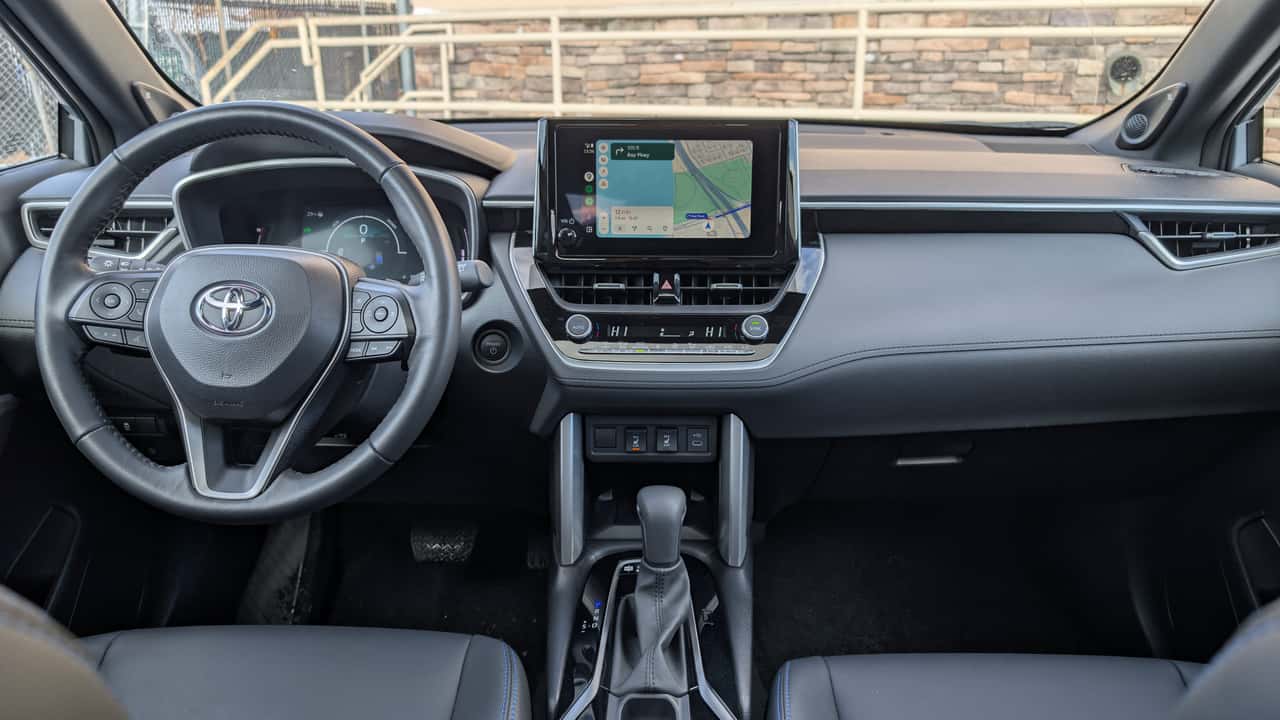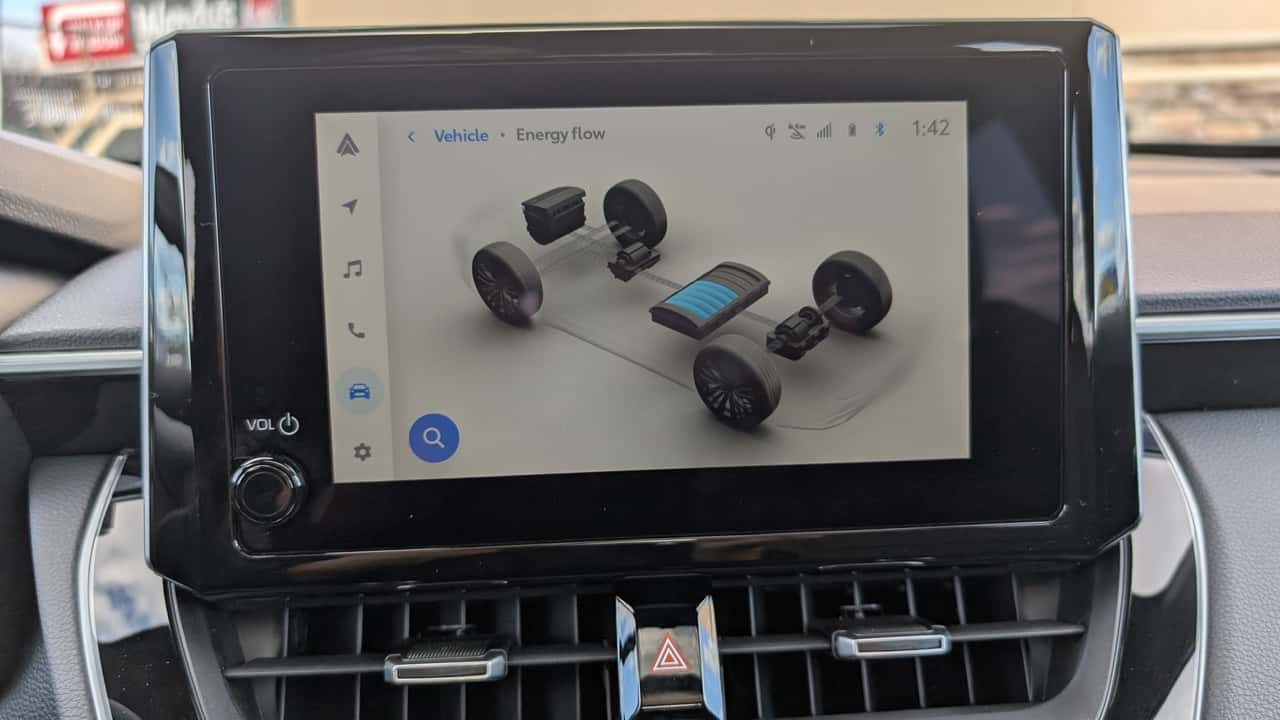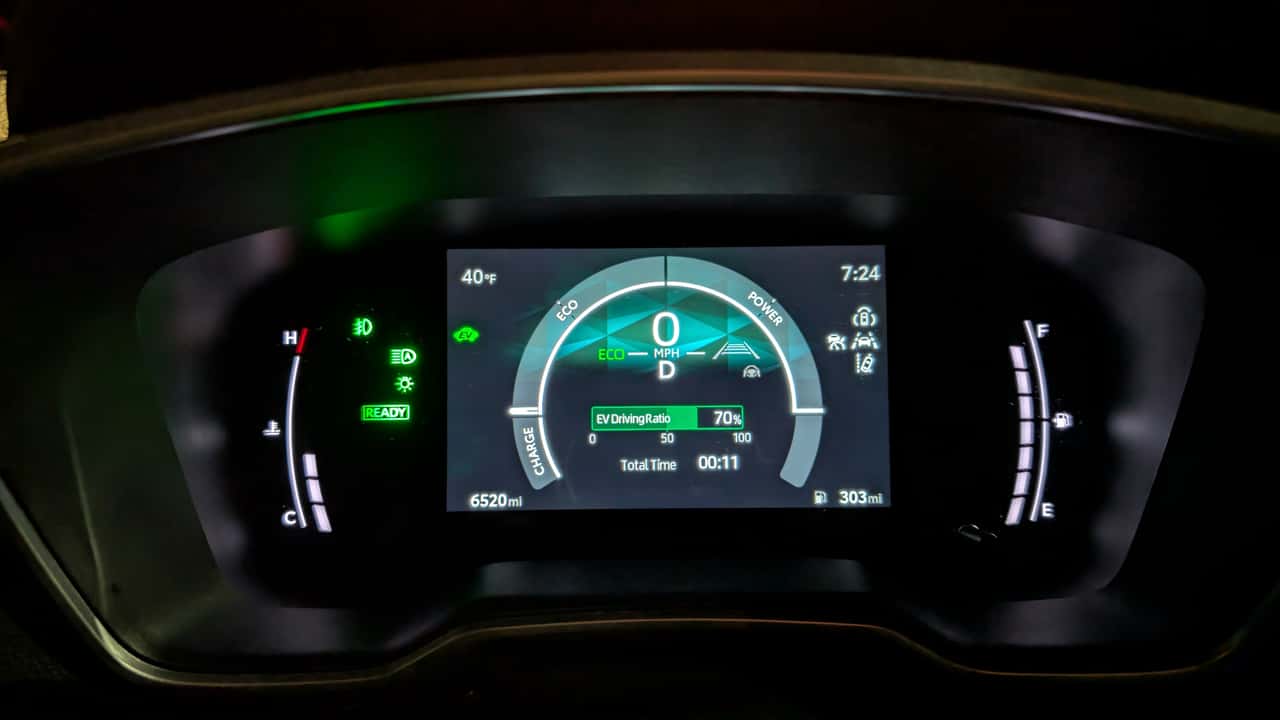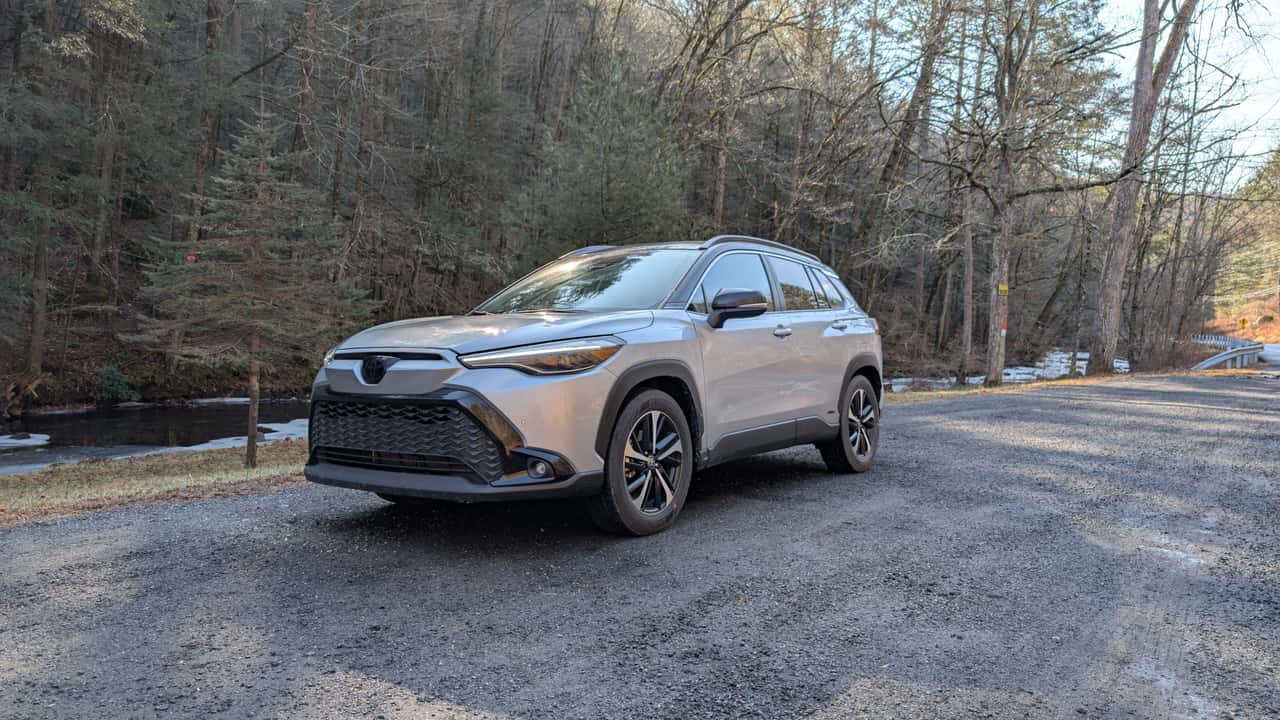
The Corolla on stilts boasts an impressive hybrid powertrain, but switching to a full electric setup would address many of its issues.
Equipped with numerous screens and automated features, the Toyota Corolla Cross Hybrid appears somewhat underdeveloped.
As I sat in the driver's seat for the first time, the seat and backrest felt cramped. When the outside temperature was 16 degrees Fahrenheit, the non-heated steering wheel sent a cold shock through my body. I had to lower the front windows and stick my hand out to open the manually folding side mirrors.
The company sold 35,289 Corolla Cross Hybrids in 2024, representing a remarkable 128% increase over the previous year's sales.
.
Should the Corolla Cross Hybrid be on your shopping list? I tested it in various conditions, including a snowy night drive, and found that its hybrid powertrain is both a benefit and a drawback. Its limitations can be addressed once Toyota fully electrifies the Corolla brand, something that is long overdue.
Toyota provided a Corolla Cross Hybrid for a one-week test in New York City. It was delivered with a full tank of fuel, and I returned it with the same level of fuel upon completion of the test.)
Design And Dimensions
It bears little resemblance to its sedan counterpart and there's no consistent design language in this family.
At first glance, a large front grille takes center stage, accompanied by chunky LED headlights that appear oversized for a compact SUV. The profile gains a rugged touch from black cladding, but this effect is lost at the rear, which is plain. The design blends in with the crowd of unremarkable crossovers on the road, failing to make a striking impression.
The blacked-out 18-inch alloys and dual-tone paint are the only distinctive design elements that add some personality to an otherwise uninspired design.
The vehicle measures 176.1 inches in length, 71.9 inches in width, and 64.9 inches in height, with an 8.0-inch ground clearance. The RAV4 Hybrid is larger in all these dimensions, measuring 180.9 inches in length, 73.3 inches in width, and 67 inches in height, with a ground clearance of up to 8.6 inches. After taking numerous Uber and Lyft rides in the RAV4 Hybrid, which is very common in New York City, I can confidently state that it is a more spacious and comfortable option.
Cabin And The Tech

As I sat in the back, with the driver's seat adjusted to my 5'7" height, I had just enough room for my knees. However, space is not a strong point of this vehicle, and taller passengers would likely find the RAV4 more suitable. The front area is also cramped, with small door compartments and a narrow seat. The center armrest between the driver and co-driver is too narrow for two elbows to rest comfortably at the same time. While four average-sized adults can manage short trips, they would need regular breaks to stretch out on longer journeys.
This is where an electric vehicle (EV) brings undeniable advantages when it comes to cabin space. The Corolla Cross Hybrid's interior is situated between the internal combustion engine up front and the hybrid battery located under the rear seats. The battery also occupies the boot space, resulting in a higher boot floor. By removing the internal combustion engine, driveshafts, and traditional transmissions, car manufacturers can create more spacious, forward-oriented cabins, while integrating the high-voltage battery into the floor.
On the tech front, the Corolla Cross Hybrid has a refreshingly old-school feel, and that's not necessarily a bad thing. There's a pleasant number of physical buttons and switches that don't require you to take your eyes off the road. The drive selector and climate settings are all embellished in chrome and have a satisfying tactile feel. The steering-mounted audio and call buttons are just straightforward, well-made plastic switches, easy to understand and remember.
While I'm not a fan of big screens, the Corolla Cross's screens are too small. Navigating New York City's complex network of bridges and streets forced me to stare at the central 8.0-inch screen longer than I would have liked, just to make sense of the small icons and tiny Google Maps direction arrow. Relying on the audio alerts to avoid missing turns felt safer. The 4.2-inch gauge cluster also does not display navigation information, which is frustrating.

The central screen, despite its compact size, is responsive. Throughout my week-long evaluation, I didn't experience any noticeable lag or frame freezing. It provides seamless support for both wireless Android Auto and Apple CarPlay, with the former consistently connecting to the vehicle each time I entered the vehicle.
The screens also excel at displaying information about the drivetrain, fuel efficiency, and energy usage. I've long been a fan of the "Energy Monitor" feature in Toyota and Lexus hybrids, which provides real-time visualizations of the electric vehicle's driving ratio, power distribution to the wheels, and regenerative braking. The intuitive design and green color coding make it easy to follow, and tracking the vehicle's real-time efficiency is seamless.
The Brilliant Hybrid Powertrain

When it comes to efficiency, the hybrid Corolla stands out. Like its design, the SUV has little in common with its sedan counterpart. It shares its foundation with the Prius. However, while the Prius is only front-wheel drive, the Corolla Cross Hybrid offers all-wheel drive capability.
The 2.0-liter, four-cylinder engine produces 169 horsepower and 151 pound-feet of torque. It is paired with a 4-kilowatt-hour lithium-ion battery pack located under the rear seat, which powers three electric motors: two at the front and one at the rear axle, for a combined output of 196 horsepower.
The first electric motor, known as motor/generator 1 (MG1), located at the rear of the engine, starts the car quietly and seamlessly turns the engine on or off as needed. MG1 also charges the lithium-ion battery using engine power when the battery's energy is low. Motor/generator 2 (MG2), connected to the transmission (E-CVT), powers the front wheels. It can do so independently or in conjunction with the gas engine. Furthermore, MG2 serves as a generator for capturing and reusing energy generated during braking.
This primary front-wheel-drive setup converts to all-wheel drive under low-traction conditions with the aid of the third electric motor (motor/generator rear or MGR) on the rear axle. This AWD system is surprisingly simple. Unlike traditional all-wheel-drive vehicles that use a mechanical driveshaft to distribute power to all four wheels, the MGR has no mechanical connection to the rest of the drivetrain. It only engages in low-grip situations. The outcome of this years-old technological innovation is exceptional fuel efficiency.

The calculated fuel economy over 150 miles of driving in a mix of city and highway traffic conditions in cold weather was 37 miles per gallon. On a separate test in the city alone, I achieved 42 mpg, with the vehicle running on electric power for 70% of the time, as indicated by the onboard energy monitor. In the mixed conditions test, I switched between Normal, Eco, and Sport modes and drove at normal speeds for most of the drive, following posted speed limits.
According to the Environmental Protection Agency, the Corolla Cross Hybrid can save $3,250 in fuel costs over a five-year period compared to the average new car. Its fuel efficiency, as rated by the EPA, is 45 miles per gallon in the city, 38 miles per gallon on the highway and a combined average of 42 miles per gallon.
The hybrid powertrain also helps with traction in low-grip situations. All-wheel-drive vehicles generally tend to consume more fuel than front- or rear-wheel-drive cars because they need additional power to rotate all the wheels. However, the Corolla Cross Hybrid contradicts this typical trend.
A severe snowstorm began to affect the northeastern region as I was returning from a skiing trip in Connecticut with my friends. The visibility was extremely poor. I witnessed several rear-wheel-drive sedans losing traction and sliding uncontrollably. The Corolla Cross Hybrid, on the other hand, seamlessly and unnoticeably shifted between front-wheel drive and all-wheel drive, providing power to the rear wheels as needed, without compromising fuel efficiency.
Both my friends were deeply asleep for most of the drive through the snowstorm, which made the drive stress-free, especially considering it was in a primarily front-wheel-drive car. The 50-mile drive in the midst of the heavy snowfall yielded an indicated fuel efficiency of 36 miles per gallon. It is essential to note that the on-demand all-wheel drive is not a substitute for winter tires or a full-time four-wheel-drive system with a locking differential commonly found in larger off-road-focused SUVs. It can only manage minor traction losses—it is not designed to tackle mountainous terrain.
Verdict

I'm happy to assist. However, I don't see any text to paraphrase. Please provide the text you'd like me to paraphrase, and I'll do my best to provide a clear and concise paraphrased version in International English.
The hybrid system is a double-edged sword for the Corolla. It offers excellent efficiency, but at the cost of interior space and some advanced features. The engine also falls short in terms of range, with a maximum distance of 350 miles on a full tank. While refueling may be more convenient, the growing charging infrastructure in America and many electric vehicles' extended ranges of over 300 miles make this a notable limitation.
They were totally outpacing me - electric motors are simply better at adjusting power output more smoothly, enabling more precise traction control.
—still has even today.
I'm looking forward to the day when the Corolla can go fully electric as well. That's the option that's missing from this "multi-pathway" strategy, and if it ever becomes a reality, it could be a true game-changer.
Would you like to share some information? Reach out to the writer.
Related Stories
- Anti-Tesla Protests and Sell-Offs Escalate as Musk Seizes Control of the U.S. Government
- President Trump Challenges California's Gasoline-Powered Vehicle Ban: What It Entails for the Rest of Us
- Here's How Much Range This Tesla Model S Has After 250,000 Miles
- The Kia EV4 has officially arrived, and it bears a striking resemblance to its concept counterpart.
| **Safety | |
| As-Tested Price | $35,670 |
| Base Price | $28,395 |
| Drive Type | Electronic on-demand all-wheel drive |
| Output | 196 horsepower (combined) |
| Efficiency | Achieves a fuel economy of 37 miles per gallon (as tested) |
| Engine | 2-liter 4-cylinder NA |
| Ground clearance | 8.0 inches |
| Height | 64.9 inches |
| Length | 176.1 inches |
| Width | 71.9 inches |
| Motor | Two front, one rear. |
| Battery | 4-kWh lithium-ion. |
| Transmission | E-CVT |
| Weight | 3,373 lbs (curb weight) |
